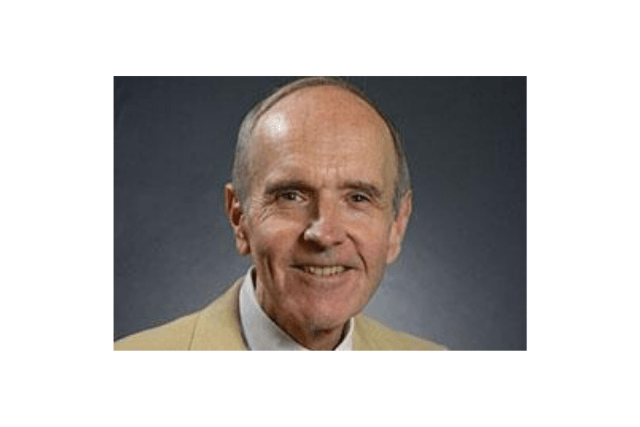
When Robert Forman, Ph.D. ‘68C was a boy, his father took him for walks on the Hillcrest Golf Course, then the highest point on Long Island (and future site of St. John’s University)—to gaze at the Manhattan skyline. “Today, my office is less than 100 feet from that hill,” Dr. Forman recently observed.
A member of the St. John’s faculty for 50 years, Dr. Forman teaches literature and Latin in St. John’s College of Liberal Arts and Sciences. He also serves as Director of the University Honors Program. As St. John’s approaches its 150th anniversary, Dr. Forman is in a unique position to track the growth and evolution of the institution and its students.
“I often talk to my literature classes about something called ‘The Eternal Return,’” Dr. Forman noted. “One way to explain that concept is that we live in a series of cyclical variations, and we often return to a variation that approximates where we started. For example, I returned to where I was as a little kid.” Dr. Forman recalled seeing a large sign posted near where Carnesecca Arena would one day be located that read, “The Future Home of St. John’s University.”
After attending St. John’s Preparatory School in Brooklyn, Dr. Forman studied at St. John’s, where he earned his bachelor’s degree in Classical Languages. He graduated that June, the weekend after Robert F. Kennedy was assassinated. The Vietnam War was at its height, and St. John’s was not immune from the politicized atmosphere enveloping most college campuses at the time, he noted. “Many of the young men graduating would be receiving draft notices soon after,” Dr. Forman recalled.
After joining the faculty at St. John’s in 1970, he attended New York University, earning his master’s and doctoral degrees in the same discipline in which he earned his bachelor’s degree.
After half a century on campus, Dr. Forman said few essentials have changed about the students he teaches. “They have a broader view of the world than we had, primarily because they come from different places around the world. They are certainly more technologically adept, but they are ambitious and idealistic, just as we were.”
Curriculum, however, has changed significantly since he came to St. John’s, Dr. Forman explained. “Today, everything is geared toward social action” and taught from a global perspective. “The English department is very different from the one I remember as a student, far more globally aware, and impressively productive."
Dr. Forman teaches Greek and Roman Literature and the University Honors Program core course in Global Literature, as well as Latin. He also offers tutorials in advanced Latin and Greek when registration does not justify a regular course. He has taught in the Honors Program since 1997, when it was housed in St. John’s College, and then when it went University-wide in 2004. He became Director in 2006.
Dr. Forman leads University Honors Program students on walking tours of New York City every fall and museum visits every spring, exposing them to all of the beauty, culture, and history the city offers. It is something that he finds very fulfilling. Very often, he sees how the University’s Vincentian mission impacts these students.
“I have been so impressed by the generosity of many students who come on the walking and museum tours,” Dr. Forman said.
“More than once, I have seen them share part of the makeshift breakfast we provide with a homeless person we meet on the way. There is an inherent generosity in these kids, and that is very encouraging.”
Recently, Dr. Forman came to campus late on a Saturday after one of these walks and encountered a family who had missed a scheduled campus tour. Their son was very interested in coming to St. John’s, so Dr. Forman showed them around campus. “There was so much natural enthusiasm in that young man that it made me feel younger,” he recalled.
The experience reminded Dr. Forman of all of the people who inspired him on his journey as a student, faculty member, and administrator. “These were people who tried to do the right thing and do the best job they could. They were good people and good examples for young people. Young people are very conscious of examples. They seem worldly, but they hunger for guidance.”
Perhaps the most important tradition Dr. Forman has honored throughout his time at St. John’s is a simple one that recalls his lesson that life is cyclical. “Immediately before summer orientation, I ‘borrow’ some of the tiny shells near the campus fountains and place them in a plastic bucket.”
At honors orientation, Dr. Forman asks each student to choose a shell to carry with them until Commencement. The shells are very small and easy to lose, yet very precious, “like many small and beautiful things. They are the same, yet each of them is different, like the students themselves.”
“The shell represents a part of the campus, their first tangible contact with St. John's, and the University Honors Program. They should see the shells as metaphors of their lives, filled with comparable variations."
The escalloped shell—an ancient symbol of the sacrament of baptism—signifies St. James Cathedral Basilica, the cathedral parish of the Diocese of Brooklyn, where the University was founded. The shell also recalls a Native American name for Long Island: “Sewanhacky” (“Island of Shells”).
Reflecting on the time he has spent at St. John’s and on the changes he has witnessed, Dr. Forman thought for a moment, and spoke emphatically: “I can say, without a doubt, I am in the right place and doing a meaningful job.”
